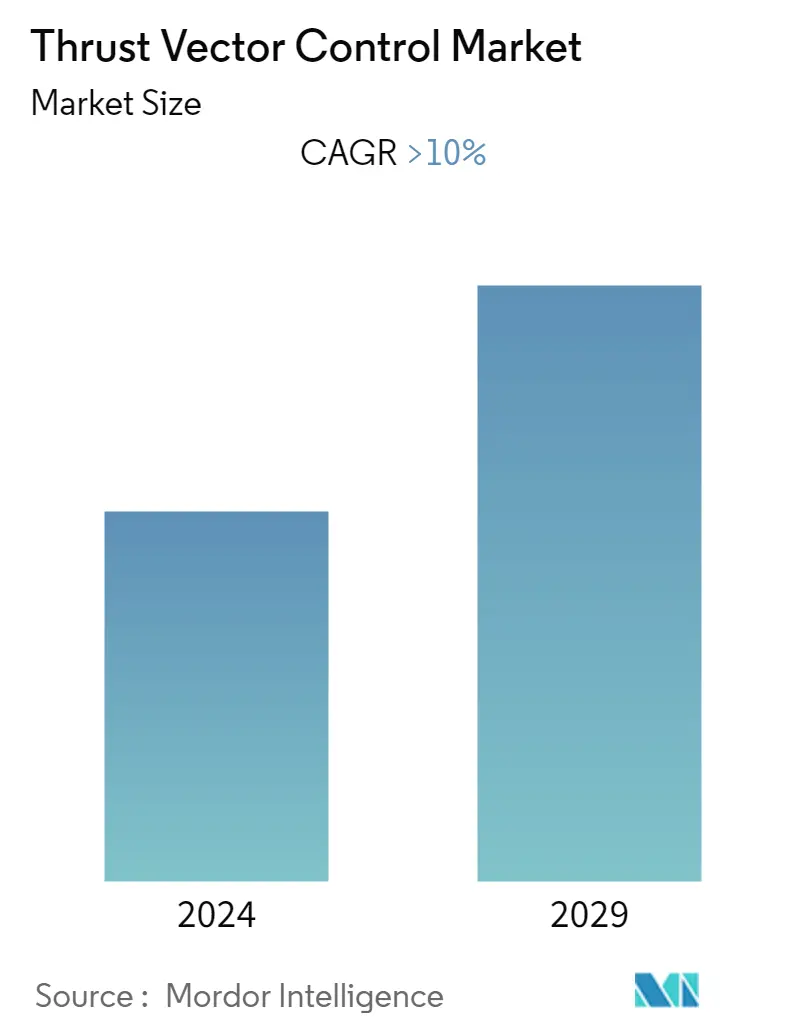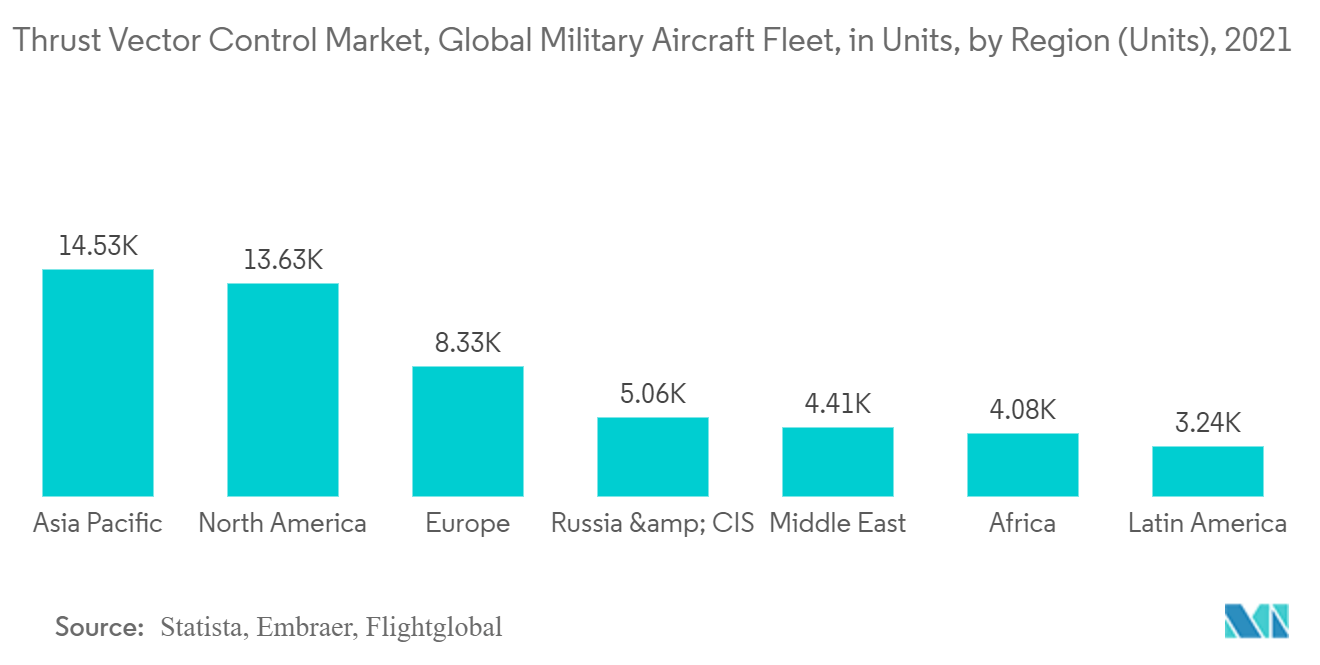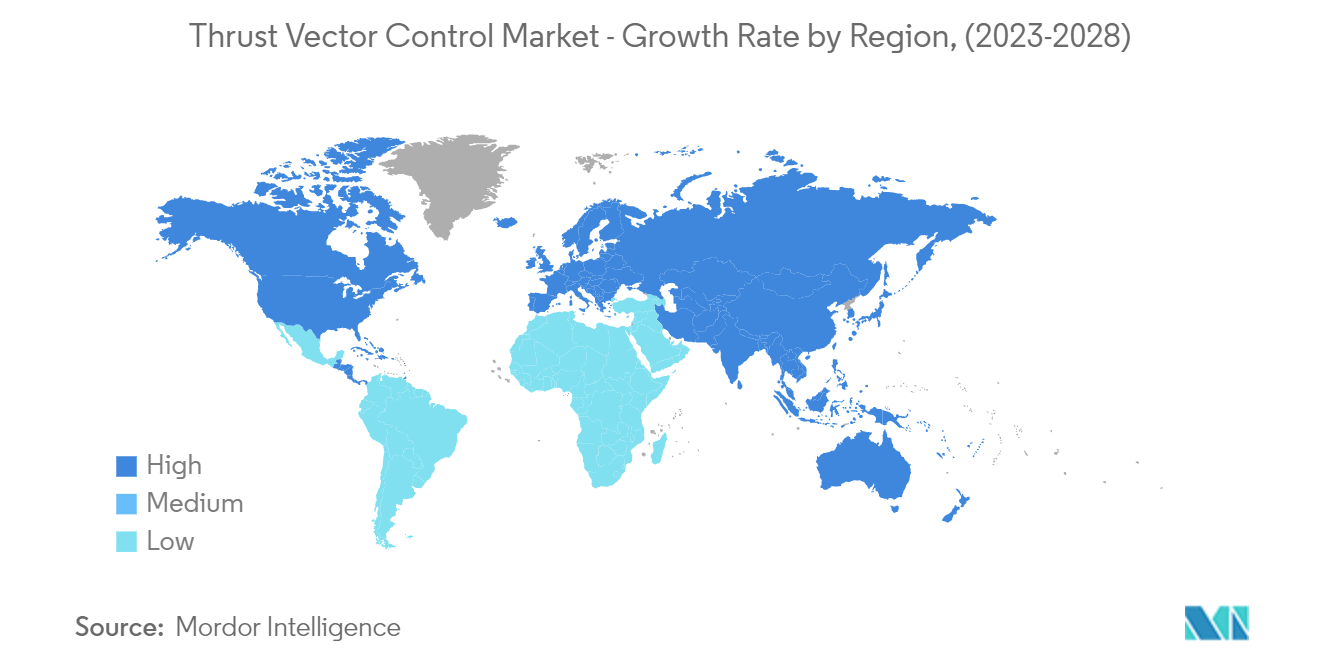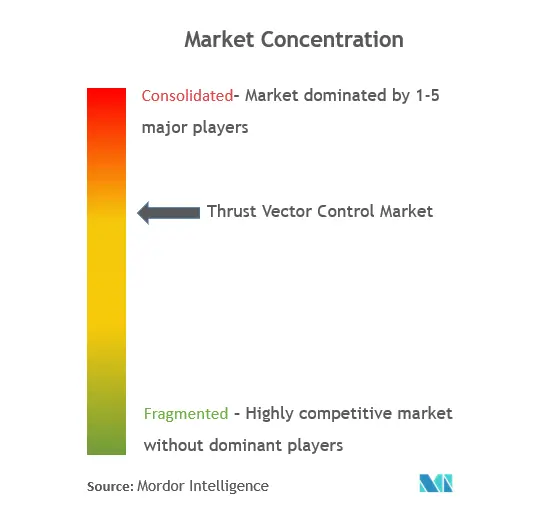Thrust Vector Control Market Size

| Study Period | 2020 - 2029 |
| Base Year For Estimation | 2023 |
| CAGR | 10.00 % |
| Fastest Growing Market | Asia-Pacific |
| Largest Market | North America |
| Market Concentration | High |
Major Players
*Disclaimer: Major Players sorted in no particular order |
Need a report that reflects how COVID-19 has impacted this market and its growth?
Thrust Vector Control Market Analysis
The thrust vector control market is anticipated to register a CAGR of over 10% during the forecast period.
- The COVID-19 pandemic severely impacted the global market for thrust vector control. Lockdowns enforced by governments resulted in original equipment manufacturers (OEMs) shutting down production, supply chain disruptions, and a decline in space exploration activities, all of which hampered the market's growth. However, the market has shown a strong recovery since then, and it is expected to grow in the coming years, driven by an increase in defense spending and rising space programs.
- Thrust vector control (TVC) is a crucial component of aerospace maneuvering, enabling an aircraft, rocket, or launch vehicle to change its flight direction by altering the thrust from its engine. The market is expected to grow during the forecast period due to an increase in the implementation of thrust vector control in fighter aircraft, growing space programs, and rising adoption of thrust vector control in next-generation guided missile systems. Furthermore, the use of flex nozzles in satellite launchers and missile systems for high-actuation power is expected to boost the market growth.
- In summary, the rising adoption of thrust vector control in fighter jets, the growing defense expenditure, and the increasing use of thrust vector control in missile systems and satellite launchers are anticipated to drive the market's growth.
Thrust Vector Control Market Trends
The Defense Segment is Projected to Dominate the Market During the Forecast Period
- The defense segment is expected to experience significant growth during the forecast period, primarily due to increasing defense expenditure and the growing procurement of next-generation fighter aircraft equipped with super maneuverability. Global defense spending surpassed 2 trillion dollars in 2021.
- The flight control system of these aircraft is installed with thrust vector control, which automatically responds to commands from the pilot. When the pilot turns the aircraft, the nozzle moves in the desired direction in conjunction with the elevator, rudder, and aileron control surfaces. Thrust vector control provides numerous advantages, including increased safety, reduced aero controls, and shorter take-off and landing runs.
- For example, at the Airshow China 2022 held in Zhuhai, South China's Guangdong Province, in November 2022, China exhibited a turbofan engine with a 2D thrust vectoring control nozzle for the first time. This engine will enhance the maneuverability and stealth capability of fighter jets, highlighting the rapid development of China's aero-engine sector. As a result, the increased adoption of thrust vector control in next-generation guided missile systems, especially in long-range missiles and intercontinental ballistic missiles, along with the rising acquisition of super maneuverable fighter aircraft, is driving the growth of the market.

North America Holds Highest Shares in the Market
- North America is expected to maintain its dominant market share throughout the forecast period. This growth can be attributed to the region's highest defense expenditure and increasing space exploration activities. The procurement of fighter jets with thrust vector control and the rising number of satellite launches are expected to further boost the market growth in the region.
- For instance, in August 2022, Ursa Major, a privately funded company based in the United States that specializes in rocket propulsion, signed a contract with the United States Air Force under the Tactical Funding Increase (TACFI) program. As per the agreement, the company will provide a flight-qualified 5,000-pound thrust, staged combustion "Hadley" rocket engine suitable for both the booster and upper-stage phases of launch for satellites into low-earth orbit. The Hadley engine features active thrust vector control, active throttle, and a configurable fuel mixture ratio. It can operate at various power levels during flight and continuously throttle from minimum to nominal flight power levels

Thrust Vector Control Industry Overview
The thrust vector control market is characterized by consolidation, with a few players holding significant market shares. Prominent market players include Honeywell International Inc., Moog Inc., BAE Systems, Woodward Inc., JASC, and others. With increasing competition, key players are focusing on developing advanced thrust vector control solutions for space and defense applications. The growing expenditure on research and development and the design and development of next-generation solutions are expected to create better opportunities in the coming years.
For instance, in November 2022, Moog Inc. announced that the company's space products played a crucial role in the successful launch of Artemis 1, NASA's first uncrewed test flight for its mission to return to the Moon. The company's thrust vector control actuators and controllers were used to steer each stage of the most powerful rocket ever built, ensuring the mission's success. Thus, the increasing spending on developing advanced thrust vector control solutions for end-users is expected to drive market growth.
Thrust Vector Control Market Leaders
-
Honeywell International Inc.
-
Moog Inc.
-
Woodward Inc.
-
JASC Corporation
-
BAE Systems PLC
*Disclaimer: Major Players sorted in no particular order

Thrust Vector Control Market News
May 2022: BAE Systems' Australian subsidiary signed a three-year contract worth USD 50 million with Raytheon Technologies' Missiles and Defense business for supplying critical software and hardware sub-assemblies as a part of the Evolved Seasparrow Missile Block 2 program. The contract includes the supply of a thrust vector controller, aerodynamic control fins, fuselage, internal structure elements, telemetry data, autopilot algorithms, and other sub-assemblies for the medium-range missile.
March 2021: Collins Aerospace, a company owned by Raytheon Technologies Corporation, successfully developed the 600th thrust vector actuation (TVA) system for the terminal high altitude area defense (THAAD) missile system. This all-electric component has guided all of THAAD's live fire intercept activities.
Thrust Vector Control Market Report - Table of Contents
1. INTRODUCTION
- 1.1 Study Assumptions and Market Definition
- 1.2 Scope of the Study
2. RESEARCH METHODOLOGY
3. EXECUTIVE SUMMARY
4. MARKET DYNAMICS
- 4.1 Market Overview
- 4.2 Market Drivers
- 4.3 Market Restraints
-
4.4 Porter's Five Forces Analysis
- 4.4.1 Bargaining Power of Buyers/Consumers
- 4.4.2 Bargaining Power of Suppliers
- 4.4.3 Threat of New Entrants
- 4.4.4 Threat of Substitute Products
- 4.4.5 Intensity of Competitive Rivalry
5. MARKET SEGMENTATION
-
5.1 Application
- 5.1.1 Launch Vehicles
- 5.1.2 Satellites
- 5.1.3 Missiles
- 5.1.4 Fighter Aircraft
-
5.2 End User
- 5.2.1 Space Agencies
- 5.2.2 Defense
-
5.3 Geography
- 5.3.1 North America
- 5.3.1.1 United States
- 5.3.1.2 Canada
- 5.3.2 Europe
- 5.3.2.1 United Kingdom
- 5.3.2.2 France
- 5.3.2.3 Germany
- 5.3.2.4 Russia
- 5.3.2.5 Rest of Europe
- 5.3.3 Asia-Pacific
- 5.3.3.1 China
- 5.3.3.2 India
- 5.3.3.3 Japan
- 5.3.3.4 South Korea
- 5.3.3.5 Rest of Asia-Pacific
- 5.3.4 Latin America
- 5.3.4.1 Brazil
- 5.3.4.2 Rest of Latin America
- 5.3.5 Middle-East and Africa
- 5.3.5.1 Saudi Arabia
- 5.3.5.2 United Arab Emirates
- 5.3.5.3 South Africa
- 5.3.5.4 Rest of Middle-East and Africa
6. COMPETITIVE LANDSCAPE
-
6.1 Company Profiles
- 6.1.1 BAE Systems PLC
- 6.1.2 Honeywell International Inc.
- 6.1.3 Moog Inc.
- 6.1.4 Woodward Inc.
- 6.1.5 JASC Corporation
- 6.1.6 SABCA
- 6.1.7 Wickman Spacecraft & Propulsion Company
- 6.1.8 Collins Aerospace (Raytheon Technologies)
- 6.1.9 Dynetics
- *List Not Exhaustive
7. MARKET OPPORTUNITIES AND FUTURE TRENDS
Thrust Vector Control Industry Segmentation
Thrust vector control (TVC), also known as thrust vectoring, is the ability of a fighter aircraft, rocket, or another launch vehicle to manipulate the direction of the thrust from its engine or motors to control the attitude or angular velocity of the vehicle.
The thrust vector control market is segmented based on application, end user, and geography. By application, the market is segmented into launch vehicles, satellites, missiles, and fighter aircraft. By end user, the market is divided into space agencies and defense bodies. By geography, the market is segmented into North America, Europe, Asia Pacific, Latin America, and the Middle East and Africa.
The market sizing and forecasts have been provided in value (USD Billion) for all the above segments.
| Application | Launch Vehicles | |
| Satellites | ||
| Missiles | ||
| Fighter Aircraft | ||
| End User | Space Agencies | |
| Defense | ||
| Geography | North America | United States |
| Canada | ||
| Geography | Europe | United Kingdom |
| France | ||
| Germany | ||
| Russia | ||
| Rest of Europe | ||
| Geography | Asia-Pacific | China |
| India | ||
| Japan | ||
| South Korea | ||
| Rest of Asia-Pacific | ||
| Geography | Latin America | Brazil |
| Rest of Latin America | ||
| Geography | Middle-East and Africa | Saudi Arabia |
| United Arab Emirates | ||
| South Africa | ||
| Rest of Middle-East and Africa |
Thrust Vector Control Market Research FAQs
What is the current Thrust Vector Control Market size?
The Thrust Vector Control Market is projected to register a CAGR of greater than 10% during the forecast period (2024-2029)
Who are the key players in Thrust Vector Control Market?
Honeywell International Inc., Moog Inc., Woodward Inc., JASC Corporation and BAE Systems PLC are the major companies operating in the Thrust Vector Control Market.
Which is the fastest growing region in Thrust Vector Control Market?
Asia-Pacific is estimated to grow at the highest CAGR over the forecast period (2024-2029).
Which region has the biggest share in Thrust Vector Control Market?
In 2024, the North America accounts for the largest market share in Thrust Vector Control Market.
What years does this Thrust Vector Control Market cover?
The report covers the Thrust Vector Control Market historical market size for years: 2020, 2021, 2022 and 2023. The report also forecasts the Thrust Vector Control Market size for years: 2024, 2025, 2026, 2027, 2028 and 2029.
Thrust Vector Control Systems Industry Report
Statistics for the 2024 Thrust Vector Control Systems market share, size and revenue growth rate, created by Mordor Intelligence™ Industry Reports. Thrust Vector Control Systems analysis includes a market forecast outlook to 2029 and historical overview. Get a sample of this industry analysis as a free report PDF download.

